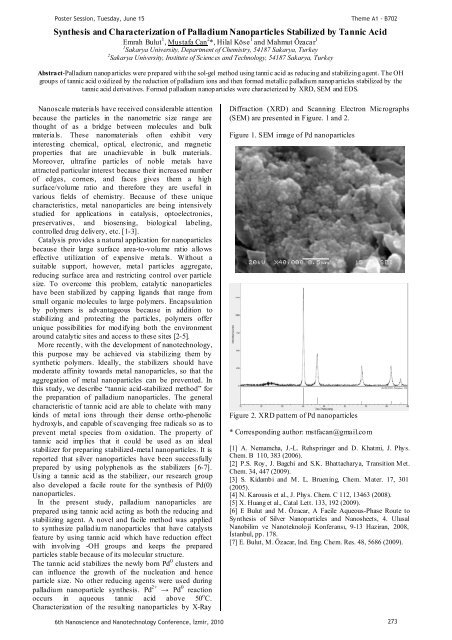Photonic crystals in biology
Photonic crystals in biology
Photonic crystals in biology
You also want an ePaper? Increase the reach of your titles
YUMPU automatically turns print PDFs into web optimized ePapers that Google loves.
Poster Session, Tuesday, June 15<br />
Synthesis and Characterization of Palladium Nanoparticles Stabilized by Tannic Acid<br />
Emrah Bulut 1 ,Mustafa Can 2 *, Hilal Köse 1 and Mahmut Özacar 1<br />
1 Sakarya University, Department of Chemistry, 54187 Sakarya, Turkey<br />
2<br />
Sakarya University, Institute of Sciences and Technology, 54187 Sakarya, Turkey<br />
Theme A1 - B702<br />
Abstract-Palladium nanop articles were prepared with the sol-gel method us<strong>in</strong>g tannic acid as reduc<strong>in</strong>g and stabiliz<strong>in</strong>g agent. The OH<br />
groups of tannic acid oxidized by the reduction of palladium ions and then formed metallic palladium nanop articles stabilized by the<br />
tannic acid derivatives. Formed palladium nanop articles were characterized by XRD, SEM and EDS.<br />
Nanoscale materials have received considerable attention<br />
because the particles <strong>in</strong> the nanometric size range are<br />
thought of as a bridge between molecules and bulk<br />
materials. These nanomaterials often exhibit very<br />
<strong>in</strong>terest<strong>in</strong>g chemical, optical, electronic, and magnetic<br />
properties that are unachievable <strong>in</strong> bulk materials.<br />
Moreover, ultraf<strong>in</strong>e particles of noble metals have<br />
attracted particular <strong>in</strong>terest because their <strong>in</strong>creased number<br />
of edges, corners, and faces gives them a high<br />
surface/volume ratio and therefore they are useful <strong>in</strong><br />
various fields of chemistry. Because of these unique<br />
characteristics, metal nanoparticles are be<strong>in</strong>g <strong>in</strong>tensively<br />
studied for applications <strong>in</strong> catalysis, optoelectronics,<br />
preservatives, and biosens<strong>in</strong>g, biological label<strong>in</strong>g,<br />
controlled drug delivery, etc. [1-3].<br />
Catalysis provides a natural application for nanoparticles<br />
because their large surface area-to-volume ratio allows<br />
effective utilization of expensive metals. Without a<br />
suitable support, however, metal particles aggregate,<br />
reduc<strong>in</strong>g surface area and restrict<strong>in</strong>g control over particle<br />
size. To overcome this problem, catalytic nanoparticles<br />
have been stabilized by capp<strong>in</strong>g ligands that range from<br />
small organic molecules to large polymers. Encapsulation<br />
by polymers is advantageous because <strong>in</strong> addition to<br />
stabiliz<strong>in</strong>g and protect<strong>in</strong>g the particles, polymers offer<br />
unique possibilities for modify<strong>in</strong>g both the environment<br />
around catalytic sites and access to these sites [2-5].<br />
More recently, with the development of nanotechnology,<br />
this purpose may be achieved via stabiliz<strong>in</strong>g them by<br />
synthetic polymers. Ideally, the stabilizers should have<br />
moderate aff<strong>in</strong>ity towards metal nanoparticles, so that the<br />
aggregation of metal nanoparticles can be prevented. In<br />
this study, we describe “tannic acid-stabilized method” for<br />
the preparation of palladium nanoparticles. The general<br />
characteristic of tannic acid are able to chelate with many<br />
k<strong>in</strong>ds of metal ions through their dense ortho-phenolic<br />
hydroxyls, and capable of scaveng<strong>in</strong>g free radicals so as to<br />
prevent metal species from oxidation. The property of<br />
tannic acid implies that it could be used as an ideal<br />
stabilizer for prepar<strong>in</strong>g stabilized-metal nanoparticles. It is<br />
reported that silver nanoparticles have been successfully<br />
prepared by us<strong>in</strong>g polyphenols as the stabilizers [6-7].<br />
Us<strong>in</strong>g a tannic acid as the stabilizer, our research group<br />
also developed a facile route for the synthesis of Pd(0)<br />
nanoparticles.<br />
In the present study, palladium nanoparticles are<br />
prepared us<strong>in</strong>g tannic acid act<strong>in</strong>g as both the reduc<strong>in</strong>g and<br />
stabiliz<strong>in</strong>g agent. A novel and facile method was applied<br />
to synthesize palladium nanoparticles that have catalysts<br />
feature by us<strong>in</strong>g tannic acid which have reduction effect<br />
with <strong>in</strong>volv<strong>in</strong>g -OH groups and keeps the prepared<br />
particles stable because of its mo lecular structure.<br />
The tannic acid stabilizes the newly born Pd 0 clusters and<br />
can <strong>in</strong>fluence the growth of the nucleation and hence<br />
particle size. No other reduc<strong>in</strong>g agents were used dur<strong>in</strong>g<br />
palladium nanoparticle synthesis. Pd 2+ 0 reaction<br />
occurs <strong>in</strong> aqueous tannic acid above 50 o C.<br />
Characterization of the result<strong>in</strong>g nanoparticles by X-Ray<br />
Diffraction (XRD) and Scann<strong>in</strong>g Electron Micrographs<br />
(SEM) are presented <strong>in</strong> Figure. 1 and 2.<br />
Figure 1. SEM image of Pd nanoparticles<br />
Figure 2. XRD pattern of Pd nanoparticles<br />
* Correspond<strong>in</strong>g author: mstfacan@gmail.com<br />
[1] A. Nemamcha, J.-L. Rehspr<strong>in</strong>ger and D. Khatmi, J. Phys.<br />
Chem. B 110, 383 (2006).<br />
[2] P.S. Roy, J. Bagchi and S.K. Bhattacharya, Transition Met.<br />
Chem. 34, 447 (2009).<br />
[3] S. Kidambi and M. L. Bruen<strong>in</strong>g, Chem. Mater. 17, 301<br />
(2005).<br />
[4] N. Karousis et al., J. Phys. Chem. C 112, 13463 (2008).<br />
[5] X. Huang et al., Catal Lett. 133, 192 (2009).<br />
[6] E Bulut and M. Özacar, A Facile Aqueous-Phase Route to<br />
Synthesis of Silver Nanoparticles and Nanosheets, 4. Ulusal<br />
-13 Haziran, 2008,<br />
<br />
[7] E. Bulut, M. Özacar, Ind. Eng. Chem. Res. 48, 5686 (2009).<br />
6th Nanoscience and Nanotechnology Conference, zmir, 2010 273













